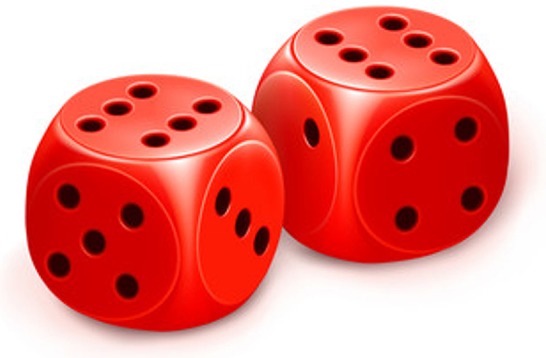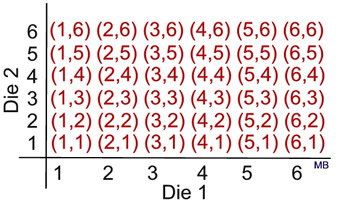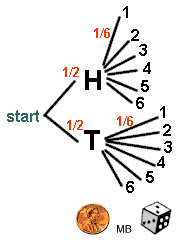|

When dealing with probability, every experiment has a set of possible outcomes, called the sample space. Probability is focused on the chance of one particular event from the sample space occurring.
If an event has only one possible outcome,
the event is called a simple (or single) event.
If an event has more than one possible outcome, the event is called a compound event.
|
A sample space is the set of ALL possible outcomes for an experiment. |
|
When determining a sample space, you must be careful to include ALL possibilities.
This may become a difficult task when the sample space becomes very large.
Let's look at some do-able examples with equally likely outcomes:
Activity/Experiment |
Sample Space as {lists} |
Tossing a Coin
(simple event)
 |
There will be 2 outcomes in the sample space.
{Heads, Tails} |
Rolling a Die
(simple event)
 |
There will be 6 outcomes in the sample space.
{1, 2, 3, 4, 5, 6} |
Draw a Card from a Standard Deck
(simple event)  |
There will be 52 cards in the sample space:
{Spades: 2,3,4,5,6,7,8,9,10, ace, jack queen, king,
Clubs: 2,3,4,5,6,7,8,9,10, ace, jack, queen, king,
Diamonds: 2,3,4,5,6,7,8,9,10, ace, jack, queen, king,
Hearts: 2,3,4,5,6,7,8,9,10, ace, jack, queen, king} |
Rolling Pair of Dice
(simple event)
 |
There will be 36 outcomes in the sample space:
{(1,1) (1,2) (1,3) (1,4) (1,5) (1,6),
(2,1) (2,2) (2,3) (2,4) (2,5) (2,6),
(3,1) (3,2) (3,3) (3,4) (3,5) (3,6),
(4,1) (4,2) (4,3) (4,4) (4,5) (4,6),
(5,1) (5,2) (5,3) (5,4) (5,5) (5,6),
(6,1) (6,2) (6,3) (6,4) (6,5) (6,6)} |
Choose Outfit
(compound event)
 |
There will be 4 possible outfit combinations
in the sample space:
{brown jacket, jeans, boots;
brown jacket, jeans, sneakers;
red jacket, jeans, boots;
red jacket, jeans, sneakers}
|
The sample space examples shown above are presented as "lists" (rosters) using
French curly braces { }. Sample spaces may also be listed as "charts".
The chart below represents an organized view of the sample space of rolling a pair of dice.

When performing an experiment, a sample space can be used in a "table" to determine the frequency of the observations, recorded with hash marks.
The table at the right shows possible outcomes from rolling a single die 20 times.
|
Roll of Die |
Frequency |
1 |
| | | | |
2 |
| | | |
3 |
| | | | |
4 |
| | | |
5 |
| | | | |
6 |
| | |
|

When attempting to determine a sample space, it is often helpful to draw a diagram which illustrates how to arrive at the answer.
One such diagram is a tree diagram. A tree diagram is a drawing with "line segments" pointing out all of the different possible "paths" for the outcomes.
In addition to helping determine the number of outcomes in a sample space, the tree diagram can be used to determine the probability of individual outcomes within the sample space.
The probability of any outcome in the sample space is the product (multiplication) of all probabilities along a path that represents that outcome on the tree diagram.
Show the sample space for tossing one penny and rolling one die. (H = heads, T = tails)
(compound event) |
 |
Start by tossing the penny. There will be two outcomes: heads, H, or tails T. This will be the beginnings of two different paths. The probability of tossing H (or T) is 1/2.
Now, from each outcome (H or T), roll one die. There will be 6 possible outcomes from the roll. The probability of rolling 1, 2, 3, 4, 5 or 6 is 1/6.
By following the different paths in the tree diagram, the sample space will be formed.
Sample Space:
{H1, H2, H3, H4, H5, H6,
T1, T2, T3, T4, T5, T6} |
The probability of each of these "path" outcomes is 1/2 • 1/6 = 1/12. |
|

There are three children in a family. How many outcomes can represent the order in which the children may have been born in relation to their gender. How many outcomes will be in the sample space indicating the gender of the children? Assume that the probability of male (M) and the probability of female (F) are each 1/2.
(compound event) |
 |
The tree is developed in the same manner seen in Example 1.
Sample Space:
{MMM,
MMF,
MFM,
MFF,
FMM,
FMF,
FFM,
FFF}
|
There are 8 outcomes in the sample space.
The probability of each outcome is
1/2 • 1/2 • 1/2 = 1/8. |
|

NOTE: The re-posting of materials (in part or whole) from this site to the Internet
is copyright violation
and is not considered "fair use" for educators. Please read the "Terms of Use". |
|









